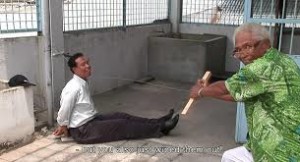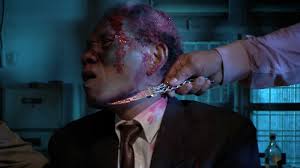 The Act of Killing (Joshua Oppenheimer & Christine Cynn, Denmark/Norway, 2013, 115 min)
The Act of Killing (Joshua Oppenheimer & Christine Cynn, Denmark/Norway, 2013, 115 min)
Union South Marquee Theater Thu Jan 30 @ 9:30pm; Fri Jan 31 @ 6:00pm»
Joshua Oppenheimer’s The Act of Killing is a documentary about the members of an Indonesian death squad, the paramilitary group called Pemuda Pancasila, who are given the opportunity to re-enact their past killings within their favorite cinematic genres. The members of the death squad—including leaders Anwar Congo and Adi Zulkadry—gained power in 1965 when the military overthrew the Indonesian government and then utilized groups of gangsters to kill thousands of communists. By allowing the paramilitary group to openly discuss their past, we are exposed to people that are rarely given the chance to speak to us frankly. We soon realize that these men are proud of their violence and thrilled to share their stories of murder, making this film a unique portrait of rare individuals.
The Act of Killing opens with a surreal scene, beautifully composed of a bright green foreground, a dark purple and blue sky background, and in the middle, women in bright-pink dresses, dancing while exiting the mouth of a gigantic fish.
In contrast to conventional documentary style, many shots here are strategically composed, symmetrically balanced and filled with brilliant colors, making the overall effect fantastically dream-like. The demeanor of the gangsters is calm and joyful, though their words are harsh and violent. Often we see the individuals doing every day, ordinary activities—like bowling, golfing or shopping—as they divulge brutal information about their past.
So as we watch Adi browse a shopping mall with his family, we hear him say, “We crushed their necks with wood. We hung them. We strangled them with wire. We cut off their heads. We ran them over with cars. We were allowed to do it.” The most screen time is devoted to Anwar Congo, a tall, curly-haired man who is usually wearing Hawaiian shirts. He is silly and joyful, smiling and dancing after showing his wire-based killing technique.

This juxtaposition between the tranquil atmosphere and aggressive statements causes uneasiness. What we see is beautiful and calm but we quickly learn that these gangsters are full of hate and the desire to kill. Though their words are violent and their descriptions about killing and raping are brutal, they initially do not show any sense of remorse or doubt about their actions and they rarely raise their temper—except when re-enacting torture scenes. Ultimately, we are confused regarding how to feel about them: they have done awful things, but they are so happy and proud of their accomplishments and their words are so unique that it is hard not to enjoy watching them.
The gangsters openly discuss in detail how they killed alleged communists, which included anyone who opposed the military reign. They refer to the time as the “Glory Days” and are proud of their mass-murders, bragging about the thrill and efficiency of each conquest. They are desensitized to violence and death, or least they are portrayed that way.
They call themselves “gangsters” because of their immense appreciation for the gangsters in American movies. Anwar especially, speaks highly of the American films and the stars that he idolized: Al Pacino, John Wayne, Marlon Brando. It can easily be inferred that these films influenced the gangsters. As Anwar walks down a darkly lit street, recalling the highlights of his past, he states, “I watched so many sadistic movies…We were influenced by them. So we were more cruel than the movies.”
 It is unethical to supply so much attention and resources to a group of violent people who have been responsible for thousands of deaths. Even if the purpose the film is to expose wrongdoing and show them the error of their ways, the recognition they are receiving can easily backfire and actually encourage and intensify hate. About halfway into the film, however, we start to see remorse from some gangsters. That remorse might not have manifested itself without asking the gangsters to re-visit their crimes. This is especially true for Anwar whose upbeat demeanor lessens after re-enacting a reoccurring nightmare in which someone he has killed comes back for revenge.
It is unethical to supply so much attention and resources to a group of violent people who have been responsible for thousands of deaths. Even if the purpose the film is to expose wrongdoing and show them the error of their ways, the recognition they are receiving can easily backfire and actually encourage and intensify hate. About halfway into the film, however, we start to see remorse from some gangsters. That remorse might not have manifested itself without asking the gangsters to re-visit their crimes. This is especially true for Anwar whose upbeat demeanor lessens after re-enacting a reoccurring nightmare in which someone he has killed comes back for revenge.
The filmmakers, for the most part, distance themselves from the on-screen space. They do not narrate over the images presented, telling us what to think about the gangsters and about their actions. Seemingly, the filmmakers put the members of the parliamentary group in front of the camera, gave them access to costumes and sets, and had them say and do whatever they wanted, allowing the audience to take from it what they will.
That being said, I remain skeptical about the level of manipulation that filmmakers exerted in editing the footage. This is because, with focusing on violent American movies, the film as a whole makes a very strong statement: these men were strongly influenced by the violent films they idolized and became violent by mimicking what they saw. For example, Anwar’s most frequent method of killing, strangling his victims with a wire, was something that he had seen in a noir-gangster film. It is commonly debated in the U.S. and elsewhere whether or not violent films, television shows, video games cause violence. The answer the filmmakers of The Act of Killing have given us is yes.
The Act of Killing, nominated for Best Documentary Feature Film at this year’s Academy Awards, has been the target of much controversy for reasons including the ones I have mentioned. Despite the questionable filmmaking decisions, the end product is a highly entertaining and intense work of art that is well-made, beautifully composed and grants access to perspectives that have rarely been seen.
If you miss the screenings at the Union South Marquee Theater this week, The Act of Killing is also currently streaming on Netflix Watch Instantly: